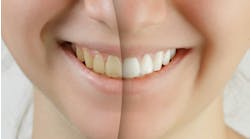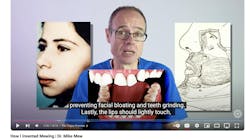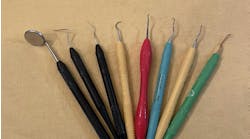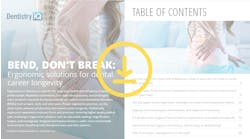You’ve probably heard the commercials on television stating that simply brushing alone isn’t enough to keep your entire mouth healthy. As dental health-care practitioners, we know that all too well. For many of our patients, however, their understanding of a well-rounded oral hygiene routine consists of brushing followed by flossing—and nothing more. We should be recommending that our patients floss, then brush, then follow with tongue hygiene and rinsing, not with water, but with an anticavity, antibacterial mouthrinse.
A study featured in the Journal of Periodontology revealed that when participants flossed prior to brushing, the amount of plaque biofilm (not only between the teeth but left in the mouth) was significantly reduced compared to the brush-floss technique.1 OK, so we’ve established a proper routine for our patients to follow; now let’s look at why it’s so important.
What secrets are our tongues hiding?
Why is it important that we address tongue hygiene2 with our patients? We know the primary reason is due to the cornucopia of bacteria coating the tongue and all oral structures. The rougher the topography of our tongues, the more easily bacteria and pathogens will find a comfortable niche to hide away in and contribute to the recolonization of bacterial colonies on hard tissue immediately after brushing, along with oral halitosis.3
Diseases most likely to affect the tongue and the importance of proper examination and diagnosis
Halitosis: Causes, ways to avoid it, and its link to your overall health
Tracy Warner of the American Academy for Oral Systemic Health (AAOSH) states that there are at least 800 species of bacteria in our mouths.4 Among these bacterial species are several periodontal pathogens: Porphyromonas gingivalis, Aggregatibacter actinomycetemcomitans, and Tannerella forsythia, “‘red complex, high-risk, or late colonizing pathogens. The high-risk pathogens are initiators of intracellular damage wherever they are found.’”5 Warner went on to say, “All of the systemically virulent pathogens from periodontal disease are pathogenic, relative to their individual or collective concentrations or to their total numbers.”
As oral health-care practitioners, we understand the impact poor oral hygiene and poor oral health can have on our patients’ systemic health. The same periodontal pathogens are implicated in at least 16 systemic diseases, not limited to diabetes, Alzheimer’s disease, preterm birth and/or low birth weight, and cancers.5
Now that our everyday lives and careers are indelibly changed due to COVID-19, we can educate our patients about the correlation between periodontal inflammation and systemic inflammation. Coronavirus is proving not only to be a respiratory virus but a systemic and long-term, inflammatory condition. Armed with these sobering facts, we have more than enough ammunition to encourage our patients to improve their personal home care routine, which needs to include tongue hygiene.
Devices for tongue hygiene
We’ve explained all the implications and consequences of not cleaning the tongue to our patients. Now, how do they do it? Point them toward any dental aisle in the supermarket or drugstore and in many cases, they’ll find at least a few different types of tongue scrapers or cleaners. Or point them in the direction of their own kitchens! A spoon could work just as well as a tongue scraper, but we should have a few different examples on hand in our operatories to show patients and explain how to use them. Demonstrating how to use a tongue scraper may be off limits now due to COVID-19 but we can at least pull up a brief YouTube video for patients to watch.
Also by the author:
Are you anxious over your anxious patients?
Convincing our patients to simply floss and brush every day, let alone twice a day, is already an uphill battle. How do we go about convincing them to add tongue hygiene to their routine? One of the most obvious points we can make is regarding bad breath. No one wants that! Some could joke that it doesn’t really matter since many are still regularly wearing masks, but that’s when the science comes into play. Appeal to their health.
Since heart conditions/diseases, diabetes, and high blood pressure (to name a few) are so common, encourage patients to add tongue scraping to their oral care routine even if these conditions are well controlled—to ensure that they stay well controlled. The healthier the mouth, the healthier the body, and vice versa.
Editor’s note: This article first appeared in Through the Loupes newsletter, a publication of the Endeavor Business Media Dental Group. Read more articles and subscribe to Through the Loupes.
References
- New study suggests the ideal sequence for removing plaque. American Academy of Periodontology. August 29, 2018. https://www.perio.org/press-release/new-study-suggests-the-ideal-sequence-for-removing-plaque/
- Choi HN, Cho YK, Koo JW. The effect of mechanical tongue cleaning on oral malodor and tongue coating. Int J Environ Res Public Health. 2022;19(1):108. doi:10.3390/ijerph19010108
- Faveri M, Feres M, Shibli JA, Hayacibara RF, Hayacibara MM, de Figueiredo LC. Microbiota of the dorsum of the tongue after plaque accumulation: an experimental study in humans. J Periodontol. 2006;77(9):1539-1546. doi:10.1902/jop.2006.050366
- Segrest S. 4 fascinating things scientists know about the billions of bacteria in your mouth. Johnson & Johnson. October 7, 2018. https://www.jnj.com/innovation/4-things-scientists-know-about-the-bacteria-in-your-mouth
- Warner T. Defining periodontal disease by its pathogens. American Academy for Oral Systemic Health. January 3, 2018. https://www.aaosh.org/connect/periodontal-disease-pathogens






